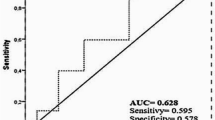Abstract
The purposes of our study were to determine the peak oxygen uptake ( V̇O2peak) per total or regional skeletal muscle (SM) mass using magnetic resonance imaging (MRI) and to investigate the relationships between SM mass and V̇O2peak during running and arm cranking. Eight male college swimmers aged 18–22 years [mean (SD) age 20.0 (1.3) years] were recruited to participate in this study. V̇O2 during running and arm cranking were measured using an automated breath-by-breath mass spectrometry system. Contiguous MRI slices were obtained from the first vertebra cervicale to the malleolus lateralis (1.0-cm slice thickness, 0-cm inter-slice gap), resulting in a total of approximately 156 images for each subject. The absolute V̇O2peak and the V̇O2peak per body mass during running and arm cranking were 3.6 (0.6) l.min-1, 54.4 (5.9) ml.min-1.kg-1 and 2.5 (0.5) l.min-1, 36.9 (5.3) ml.min-1.kg-1, respectively. The absolute V̇O2peak was higher ( P <0.05) during running than during arm cranking, but not the V̇O2peak per regional area SM mass. The lower body SM mass was correlated to the V̇O2peak during running ( r =0.95, P <0.001). All measurements and calculated values were expressed as the mean (SD) for the eight subjects. To eliminate the influence of body mass and fat-free mass (FFM), a regression analysis was performed on the mass-residuals of the V̇O2peak during running and the lower body SM mass. The residuals of lower body SM mass were correlated to the residuals of V̇O2peak during running, with respect to body mass ( r =0.90, P <0.001) and FFM ( r =0.82, P <0.05). These results suggest that the MRI-measured lower body SM mass was closely associated to the absolute V̇O2peak during running, independently of body mass or FFM, and that the V̇O2peak per regional SM mass corresponded, regardless of the type of exercise (upper or lower body).


Similar content being viewed by others
References
Abe T, Kearns CF, Fukunaga T (2003) Sex differences in whole body skeletal muscle mass measured by magnetic resonance imaging and its distribution in young Japanese adults. Br J Sports Med 37:436–440
Andersen P, Saltin B (1985) Maximal perfusion of skeletal muscle in man. J Physiol 366:233–249
Bassett DR Jr, Howley ET (2000) Limiting factors for maximum oxygen uptake and determinants of endurance performance. Med Sci Sports Exerc 32:70–84
Brozek J, Grande F, Anderson JT, Keys A (1963) Densitometric analysis of body composition: revision of some quantitative assumptions. Ann NY Acad Sci 110:113–140
Howley ET, Bassett DR Jr, Welch HG (1995) Criteria for maximal oxygen uptake: review and commentary. Med Sci Sports Exerc 27:1292–1301
Hunt BE, Davy KP, Jones PP, DeSouza CA, Van Pelt RE, Tanaka H, Seals DR (1998) Role of central circulatory factors in the fat-free mass-maximal aerobic capacity relation across age. Am J Physiol 275:H1178–H1182
Kitagawa K, Ikuta K, Hara Y, Hirota K (1974) Investigation of lean body mass as a limiting factor of maximum oxygen uptake. Jpn J Phys Educ 23:96–100
Magel, JR, McArdle WD, Toner M, Delio DJ (1978) Metabolic and cardiovascular adjustment to arm training. J Appl Phyiol 45:75–79
McArdle, WD, Katch FI, Katch VL (2001) Exercise physiology, 5th edn. Lippincott Williams & Wilkins, Philadelphia, pp319–320
Mendez J, Lukaski HC, Buskirk ER (1984) Fat-free mass as a function of maximal oxygen consumption and 24-hour urinary creatinine, and 3-methylhistidine excretion. Am J Clin Nutr 39:710–715
Mitsiopoulos N, Baumgartner RN, Heymsfield SB, Lyons W, Gallagher D, Ross R (1998) Cadaver validation of skeletal muscle measurement by magnetic resonance imaging and computerized tomography. J Appl Physiol 85:115–122
Neder JA, Nery LE, Silva AC, Andreoni S, Whipp BJ (1999) Maximal aerobic power and leg muscle mass and strength related to age in non-athletic males and females. Eur J Appl Physiol 79:522–530
Proctor DN, Joyner MJ (1997) Skeletal muscle mass and reduction of V O2max in trained older subjects. J Appl Physiol 82:1411–1415
Richardson,RS, Saltin B (1998) Human muscle blood flow and metabolism studied in the isolated quadriceps muscles. Med Sci Sports Exerc 30:28–33
Schantz, P, Randall-Fox E, Hutchison W, Tyden, Astrand PO (1983) Muscle fiber type distribution, muscle cross-sectional area and maximal voluntary strength in humans. Acta Physiol Scand 117:219–226
Seals DR, Mullin JP (1982) V O2max in variable type exercise among well-trained upper body athletes. Res Q Exerc Sport 53:58–63
Shephard RJ, Bouhlel E, Vandewalle H, Monod H (1988) Muscle mass as a factor limiting physical work. J Appl Physiol 64:1472–1479
Taguchi S, Ueda K, Hata Y, Yamaji K, Miyashita M (1976) Maximal oxygen uptake and its relationship to body composition of non-athletes and athletes (swimmers), with special reference to total body potassium. Jpn J Phys Educ 21:19–26
Toth MJ, Goran MI, Ades PA, Howard DB, Poehlman ET (1993) Examination of data normalization procedures for expressing peak V O2 data. J Appl Physiol 75:2288–2292
Author information
Authors and Affiliations
Corresponding author
Rights and permissions
About this article
Cite this article
Sanada, K., Kearns, C.F., Kojima, K. et al. Peak oxygen uptake during running and arm cranking normalized to total and regional skeletal muscle mass measured by magnetic resonance imaging. Eur J Appl Physiol 93, 687–693 (2005). https://doi.org/10.1007/s00421-004-1250-y
Accepted:
Published:
Issue Date:
DOI: https://doi.org/10.1007/s00421-004-1250-y




